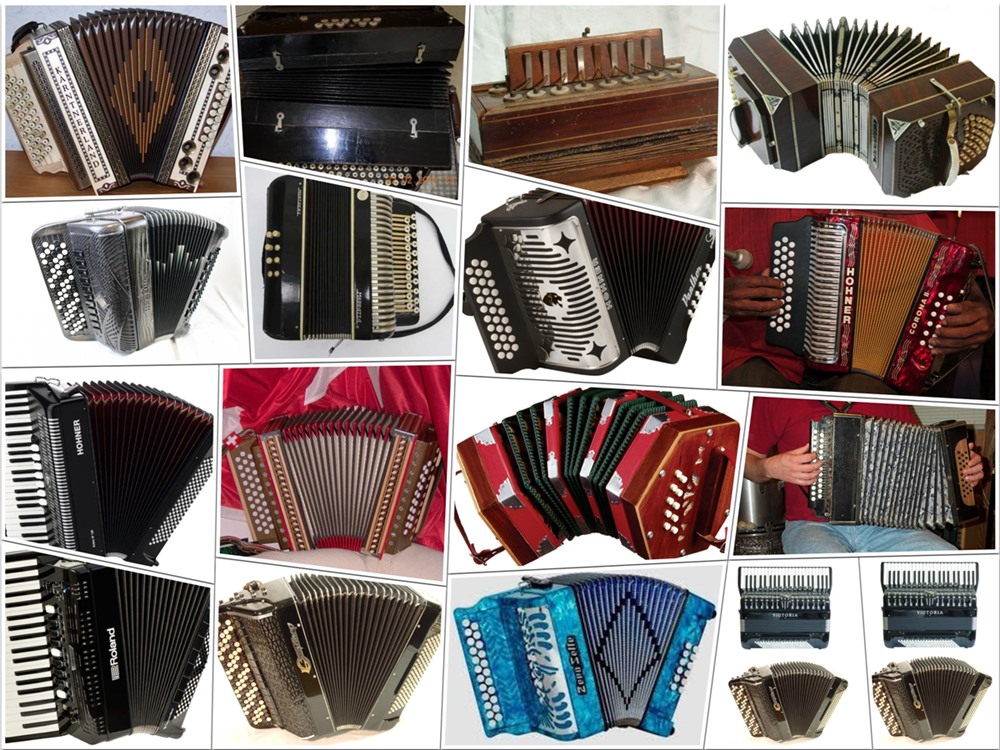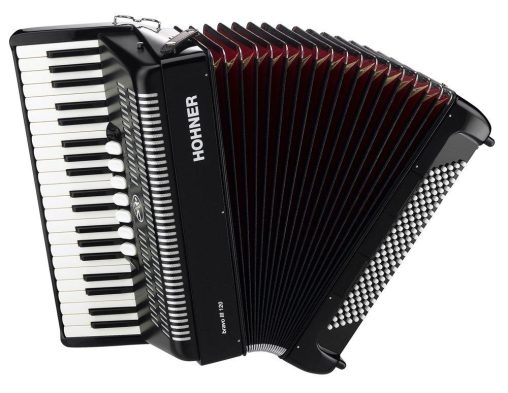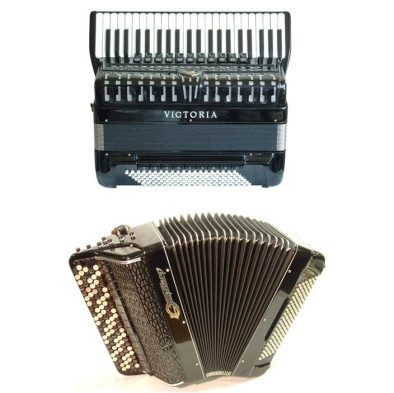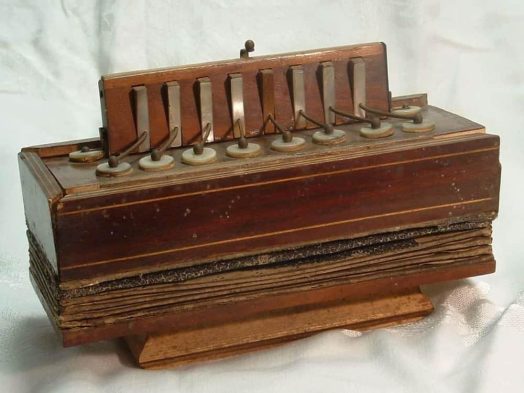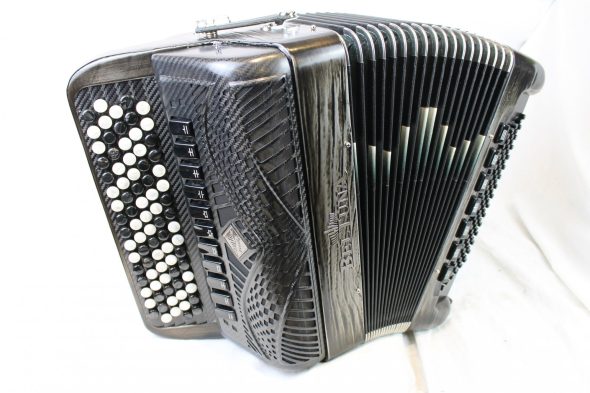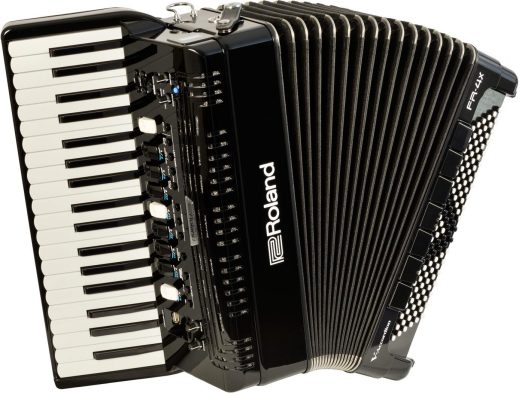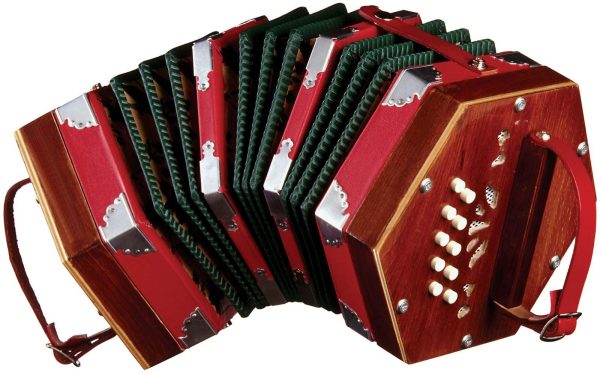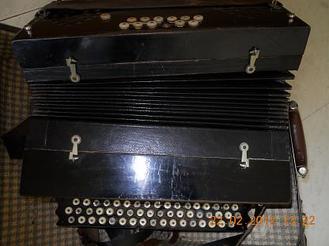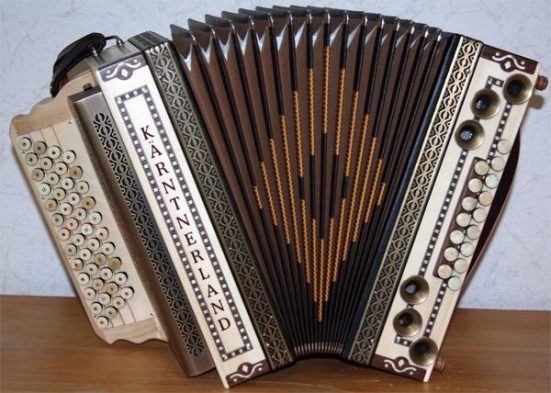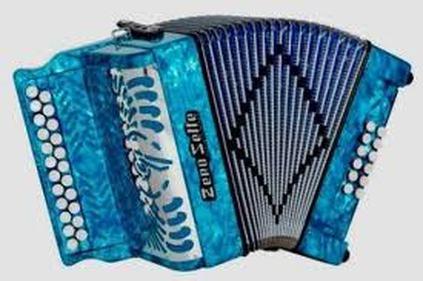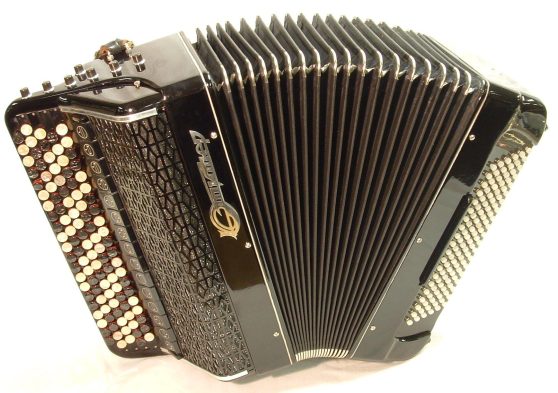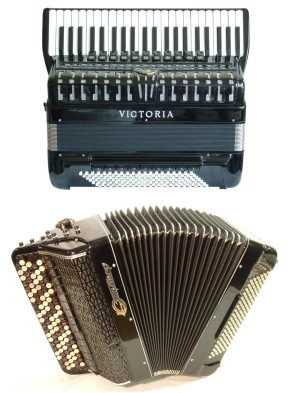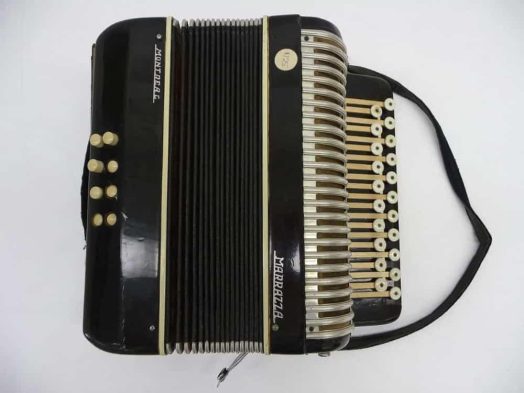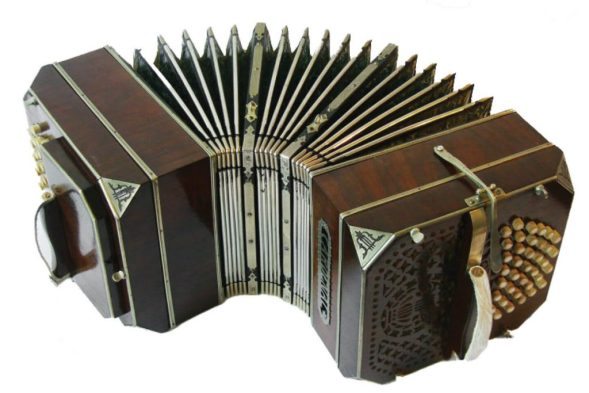The word “accordion” comes from the German word “akkord,” which meaning “musical chord” or “sound concordance.” The accordion belongs to the squeezebox, free-reed, aerophone instrument family. A reed is placed into a frame above an aperture in these instruments. The reed vibrates when air flows through the gap, which generates musical notes. The accordion is a descendant of free-reed instruments, the oldest of which is said to have been invented in China in the second millennium BC. The instrument was known as the “sheng,” and it resembled a mouth pipe organ. It is still performed today.
The modern accordion is said to have been invented by Christian Friedrich Ludwig Buschmann in Berlin in 1822. However, there is considerable debate regarding this. According to Russian experts, Timofey Vorontsov in Tule in 1820 and Ivan Sizov in 1830 invented the first basic accordion. The first accordion was invented in Vienna by Austrian-Armenian inventor Cyrill Demian; however, unlike current models, this accordion featured just buttons instead of a keyboard, and the right hand operated the bellows.
The accordion was introduced to Britain from Germany in 1828; originally, it was not well received by the British public, but it quickly gained popularity. The accordion’s popularity grew fast in Europe as a result of the Industrial Revolution. Accordions were being produced in Germany and Austria by the 1840s and in Russia, France, and Italy. As the accordion grew in popularity, its makers attempted to change its image from a folk instrument to a more “respectable” instrument.
Hohner, a famous German accordion maker, began producing classical sheet music in the 1920s, effectively transitioning the accordion from a folk instrument to a classical instrument. It also established an accordion college and formed an ensemble to tour Germany and surrounding countries, presenting the accordion in a new light. The firm has now relocated its manufacturing operations to China, becoming the world’s largest accordion maker.
Nowadays, the accordion is heard not just in ethnic or folk music but also in pop music, rock, and pop-rock and sophisticated classical music events.
Different Types of Accordion Names With Pictures
Here is the latest list of all types of accordion names with pictures and images that you should know about.
1. Button Accordion
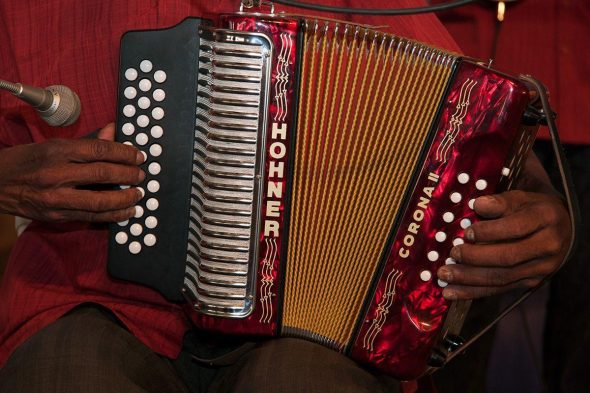
2. Piano Accordion
The piano accordion is the second most common form of accordion, and it features a keyboard that is similar to that of a piano. The layout and design of the right-hand treble keyboard are identical to that of a conventional piano. There are 41 treble keys and roughly 3+ octaves of notes on a full-size accordion. A board of buttons for bass accompaniment may be found on the left side. There are 120 buttons on a full-size piano accordion, although some versions have 140. Free bass, straddle, or French 3-3 bass systems are all options. The brass buttons, on the other hand, are most often set up in the straddle manner.
Students learning to play the piano accordion begin with a “12 bass” accordion, which features 12 bass buttons for the left hand and a two-octave keyboard for the right. The most common full-size piano keyboard range is from low “F” to high “A.”
The piano accordion has the advantage of being extremely adaptable and capable of playing any music. The piano accordion is widely utilized in folk music in the United States, but it is now increasingly being employed in current pop music. The accordion is even more prevalent in Brazil than the guitar, and it is utilized in popular music styles such as the Forro and Sertanejo. It’s also a standard instrument in Italian, German, and Balkan music.
3. Unisonic Accordion
Another significant distinction between accordions is whether they are uneconomic or bisonoric. These words describe how the bellows move air through the reeds to generate notes and pitches. In a unisonoric accordion, a key or button generates the same angle or message regardless of the direction in which the bellows move. The size of the instrument also determines the accordion’s pitch.
4. Bisonoric Accordion
When a button on a bisonoric accordion is pressed, it creates two distinct notes or pitches, depending on the orientation of the bellows. When the bellows are drawn out, a different message is produced, and a new sound is produced when they are pushed in.
5. Chromatic Accordion
Both the right-hand treble and left-hand bass sides of chromatic accordions feature buttons. The bass button layout on these accordions is comparable to that of a piano accordion, generally straddle or free bass. With the treble side containing a button layout of 3, 4, or 5 rows of buttons, the instrument has a broader pitch range. The treble side generally contains a C-Grif or a B-Grif, but the notes are placed on the keyboard in a slightly different way, with C in the first row of the C-system and B in the third row of the B-system.
The C-system is ideal for playing chords, but the B-system is more suited to classical music. Although chromatic accordions are utilized in a wide range of musical forms, tuning the accordion’s reeds is crucial. They’re most commonly heard nowadays in classical music with a free bass or converter and in Balkan and Russian folk music. These instruments are prevalent in Europe, despite their lack of popularity in the United States.
The Russian Garmon and the Finnish C-system are two types of the chromatic accordion. Although they are less frequent, they feature somewhat different keyboard styles and layouts than B-system and C-system chromatics.
6. Diatonic Accordion
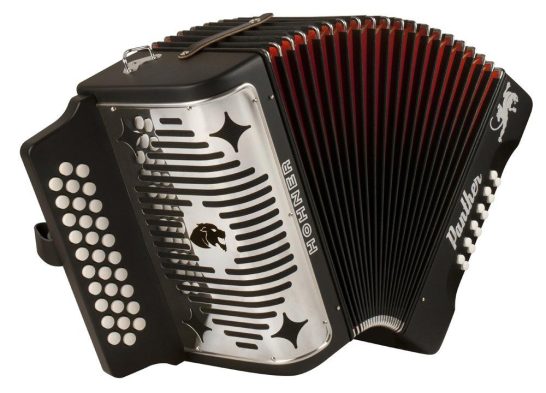
These accordions can only play particular keys due to their diatonic style. C, F, G keys or Eb, B, and F keys may be found on a model with three rows of buttons. There are many more keys accessible.
Single-row diatonic accordions are particularly popular in Celtic music, while Norteno and Cajun artists virtually exclusively utilize this type of accordion. In Zydeco music, the diatonic accordion is also used.
7. Digital Accordion
Accordions have joined the microprocessor bandwagon as technology progresses. Onboard electronics are standard on digital accordions. However free reeds may or may not be included. These accordions, too, have the appearance and feel of traditional accordions. The main benefit is that they can now generate a broader range of sounds and include effects such as chorus and reverb, and are MIDI compliant.
8. Concertina Accordion
Despite not being a “real” accordion, the concertina has enough features to be recognized as an accordion variation. Concertinas are tiny free-reed hand-held instruments that differ from the accordion. These accordions are ideal for traveling because of their small size, and they are frequently linked with sailors who carry musical instrument on their voyages.
There are numerous types of concertinas, including English, Anglo, German, and Duet concertinas. This instrument can be uneconomic, as with the chromatic accordion, bisonoric, and diatonic button accordions. Concertinas are a popular instrument for playing traditional folk music in Europe, particularly Ireland.
9. Russian Garmon Accordion
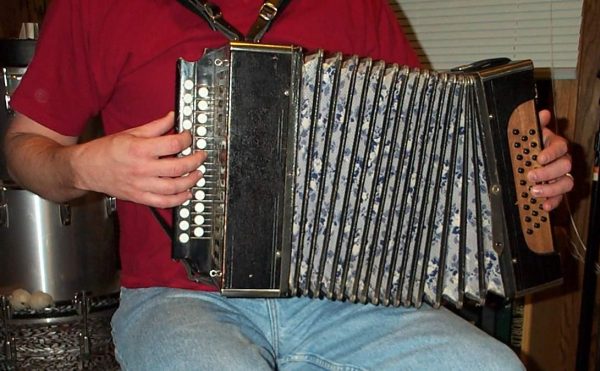
The garmon is popular among Armenian, Azeri, Ossetian, Cherkess, Georgian, and Mari people in the Ural and Volga regions and Russian traditional music. In Slovenia, it is also an essential instrument. The garmon can also play certain current music, which has acquired appeal in the United States and Europe.
10. Schrammel Accordion
This accordion includes a chromatic button accordion on the treble side and a diatonic, bisonoric 12-button keyboard on the bass side. This accordion is called after the Schrammelquartet, a classic combination of two violins, clarinet, accordion, and contraguitar.
11. Steirische Harmonika Accordion
This is a bisonoric diatonic button accordion commonly found in Czech, Slovenian, Austrian, Bavarian, and Italian South Tyrol traditional music. The deeper bass notes of this accordion are distinguished by the existence of a single key per scale row that provides the same pitch whether the bellows are drawn out or pushed in.
12. Schwyzerörgeli Accordion
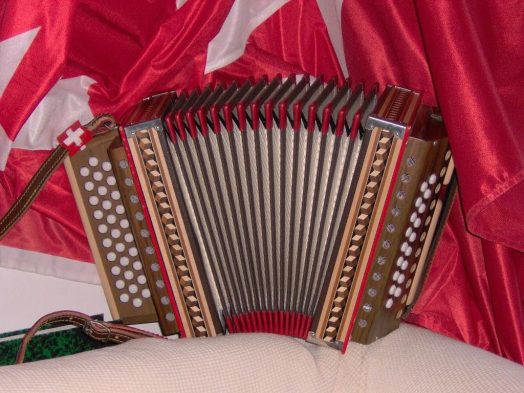
13. Trikitixa Accordion
This accordion, also known as trikini, is a two-row diatonic instrument unique to the Basque people. It has a 12-button bisonoric treble and a diatonic, Unisonic bass. This is Basque Country’s national musical instrument.
14. Bayan Accordion
Boyan is a chromatic button accordion invented in Russia in the twentieth century and named for the 11th-century minstrel. Bayan accordions have reeds that are wider and more rectangular than western button accordions. The melody-side keyboard is connected to the body’s center, and the reeds are not tremolo-tuned. The Bayan’s bass has a considerably fuller sound than its Western equivalents due to other stylistic variances.
15. British Chromatic Accordion
In Scotland, this is the most popular accordion. The left hand uses the straddle system, whereas the bisonoric system is used by the right. This accordion features a special kind known as the “Shand Morino,” a German-made accordion created by Hohner.
16. Pedal Harmony Accordion
In Polish traditional music, this particular style of the accordion is frequently employed. It features a set of bellows that seem like they belong on a pump organ.
17. Bandoneon Accordion
A concertina is a kind of Bandoneon. The Bandoneon is much bigger than its smaller, more compact concertina cousins, and it requires knee support during performances. Unlike the ordinary concertina, commonly used in folk music, Heinrich Band designed the Bandoneon to be used in 19th-century religious and popular music. Bandoneons are frequently employed in tango music because they provide a unique sound ideal for the genre.
Astor Piazzolla, one of the most prominent Bandoneon musicians, reinvented the tango by mixing classical and jazz elements into the music style.
How Does Accordion Produce Sound?
The accordion is a wind instrument that produces sound by using pleated bellows and banks of metal reeds. The most common accordion designs include two keyboards on either side of the bellows, with buttons or keys on each side.
You make a sound by extending and compressing the bellows while playing the melody on the right keyboard and chords/bass on the left. This action opens valves, allowing air to travel across the metal reeds and generate music.
Accordions can hold notes for long periods than most other musical instruments.
What Is The Easiest Type Of Accordion For Beginners To Learn On?
You must first assess your level of musical instrument knowledge. Do you know how to play any other instruments? You can learn to play the piano accordion if you already know how to play the piano. This is because their keyboards are identical. It’s also simpler to take up and play the piano accordion if you know how to play the guitar or brass instruments.
You must understand why you want to learn to play the accordion. What are your plans for the game? Will you be transporting it regularly? It would help if you studied on a piano accordion to learn how to play current jazz or more complicated sounds.
However, if you’re a complete beginner, the button accordion is a better choice for you for the reasons stated above. Although some people found the piano accordion to be simpler to start with, most novices preferred the button accordion since it is lighter and easier to move around.
It’s also a question of personal taste, dependent on how much emphasis you place on aesthetics or the price of each accordion.
What To Consider When Choosing Your Accordion
There are many different varieties of accordions available. Button and piano accordions are the two primary types.
The button and piano accordions have already been described, and each has its unique set of advantages and disadvantages. All you have to do now is pick the one that best suits your objectives.
The majority of chromatic button accordions are uneconomic. This implies that regardless of the bellow’s motion direction, they only generate one pitch. Unisonic and chromatic accordions are found on all piano accordions.
What You Will Use It For
What are your plans with your accordion? Do you intend to perform a variety of melodies or keyboard music? If you wish to accomplish that, the piano accordion is excellent since it allows you to play complicated notes without using other musical instruments.
The button accordion can play traditional music, but it requires additional musical instruments to play keys that the accordion cannot play. When you don’t want to get into the nitty-gritty of music, the button will suffice.
Convenience and Portability
Because it is smaller and lighter, the button accordion wins in terms of ease and portability. However, mini-piano accordions are now available that are lighter and simpler to transport.
Mini-piano accordions are inexpensive and ideal for learning the fundamentals before moving on to a more intermediate accordion. They’re also a lot of fun because they’re tiny and light enough to pick up and play with.
One such enjoyable and easy-to-play beginning mini-accordion is the Wal Front 22-key, 8 Bass Piano Accordion.
The body of this accordion is made of maple wood and weighs around 7.5 pounds. It’s ergonomically constructed for flexibility, and it sounds fantastic despite its low price.
Cost
Accordions with more reeds are often more costly than accordions with fewer reeds. Button accordions are less expensive than piano accordions. Not all expensive accordions are the greatest, and not all inexpensive accordions are the worst.
Weight and Size
Are the accordion’s weight and size proportional to your body type and size? Yes, you must consider if you are capable of carrying and playing the accordion simultaneously.
Spending money on the greatest accordion is pointless if you can’t handle it and play it. Is it sufficiently portable? Would you be able to bring it to your performances with you? These are the kinds of questions you should ask yourself before buying an accordion.
Compression And Reeds
It’s also essential to inspect the compression and reeds. The bellows may be expanded or compressed to play the accordion. Is it simple for you to extend and compress the bellows? How many reeds does your piece necessitate?
With its fewer reeds (4), the button accordion is ideal for performing energetic and traditional music. On the other hand, the piano accordion has more reeds (16) and is better suited to contemporary jazz and comparable sounds.
What Type Of Accordion Is Easier To Play?
A piano accordion will be easier to learn if you have prior piano knowledge. Once you’ve mastered the buttons, a button accordion is usually easier to play.
The button accordion features tiny, close-together buttons that make it simpler to play various intervals and ranges. In comparison to a piano accordion, you’ll have more fingering possibilities.
The fingering on a keyboard accordion is restricted. To come near to the button accordion’s ranges, you’ll have to hop about more. Unless you pick a mini-accordion, a piano accordion is also larger and heavier.
The best way to figure out which accordion is right for you is to play both when it comes down to it. Pick one and begin playing so that you may start training and improving each day.
What’s The Difference Between Concertinas and Accordion?
Concertinas and accordions have significant internal and exterior distinctions, despite their similarity in concept. The manner the buttons are pressed is the most noticeable. The concertina buttons are put into the instruments in the same direction as the bellows travel. The “bass” accordion buttons are pushed perpendicular to the bellows. Another distinction is that most accordions have a bass that can play a full chord, whereas concertina buttons only play one note at a time.
In 1829, Cyrill Demian of Vienna, Austria, submitted the first patent for an “accordion.” The concertina was patented by both German Carl Friedrich Uhlig (1834) and Englishman Sir Charles Wheatstone (1844) a few years later. These developments resulted from years of experimentation by European instrument manufacturers attempting to improve the fundamental idea of a portable instrument that uses a bellows to blow air across free reeds (reeds that do not beat against another surface). Exotic names were given to these early attempts, such as gasoline, hand physhamonika, and fluting.
Both instruments are available in a variety of configurations. Which one is best for you is determined by the type of music you want to play. The piano accordion is perhaps the most well-known accordion system, used in polka and other European music and, more lately, zydeco, country, and rock. Piano accordions, as the name implies, produce music using a piano-style keyboard and bass. However, certain accordions, such as those used in klezmer music, have buttons. Some button accordions utilize a diatonic scale (notes arranged in the order of the white keys of a piano) for melody notes. Others agree buttons in a chromatic scale (similar to how white and black keys on a piano are arranged).
There are several concertina systems, each with slightly deceptive titles when considering the folk music traditions in which they are used. English concertinas are more popular among Scottish and American folk artists; German concertinas, also known as Chemnitzer concertinas, are played in the American Midwest; and there is also the Bandonion, which is utilized in Argentinean folk music.
Getting accustomed to the bass layout is maybe the most difficult element of learning to play the accordion. There is 120 bass in standard accordions. However, other versions have 72 basses in 12 rows of six columns. Columns are placed according to the Circle of Fifths in the Stradella bass arrangement, with each column a fifth higher than the one next to it. The first two rows are single notes, while the next four rows, in that sequence, give major, minor, seventh, and diminished chords.
Conclusion
The accordion is utilized in a broad range of musical styles and genres across the world. If we were to go, we might hear a lot of Classical music in Russia, the musette waltz sound in France, the vibrant Celtic genres in Ireland and Scotland, and ultimately the romantic sound in Italy. Let’s not forget about jazz from the United States! The accordion is such a versatile instrument, and it’s been a lot of pleasure showing you all of the many varieties!
